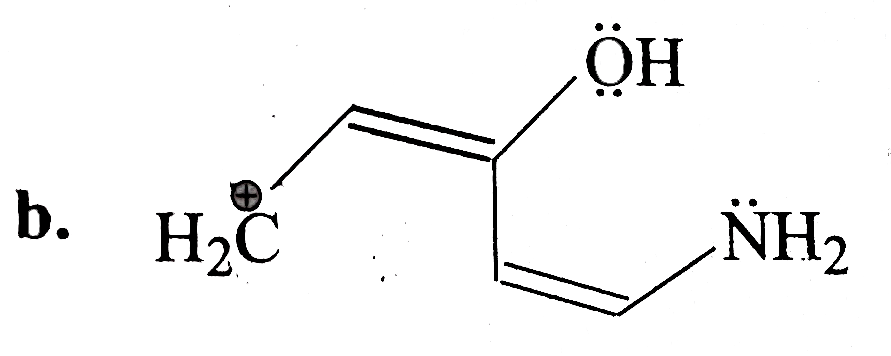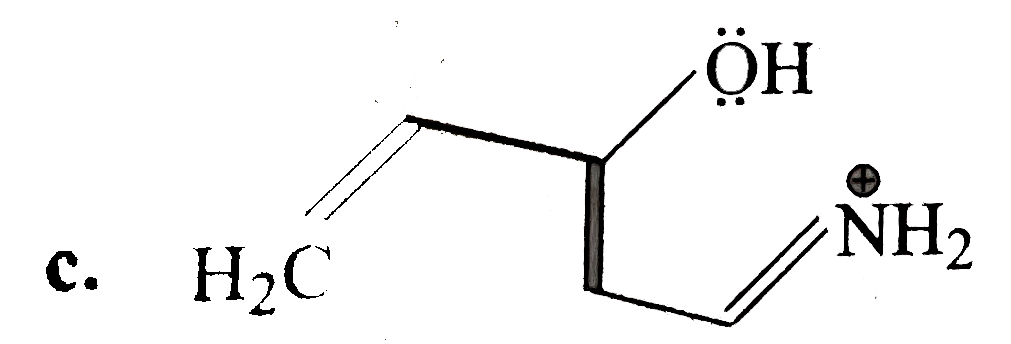Which of the following is the most stable resonance structure ?




To determine the most stable resonance structure, we need to evaluate the given resonance structures based on three key principles:
1. Neutral vs. Charged Species: Neutral resonance structures are generally more stable than charged ones.
2. Number of Covalent Bonds: Structures with more covalent bonds are typically more stable.
3. Electronegativity and Charge: Negative charges should reside on more electronegative atoms, while positive charges should be on less electronegative atoms.
Step 1: Identify the Resonance Structures
- Let's assume we have four resonance structures labeled A, B, C, and D. We need to analyze each of these structures.
Step 2: Evaluate Neutrality
- Check if any of the resonance structures are neutral. If any structure is neutral, it is more stable than those with charges.
Step 3: Count Covalent Bonds
- Count the number of covalent bonds in each structure:
- Structure A: Count the bonds (e.g., 8 bonds).
- Structure B: Count the bonds (e.g., 8 bonds).
- Structure C: Count the bonds (e.g., 9 bonds).
- Structure D: Count the bonds (e.g., 9 bonds).
Step 4: Analyze Charges
- Identify the location of charges:
- Check where the positive and negative charges are located.
- Positive charges on more electronegative atoms (like oxygen) are less stable.
Step 5: Compare Stability
- Based on the number of covalent bonds and the location of charges, compare the stability of the structures:
- If Structure C and D have the most covalent bonds, they may be more stable.
- If Structures A and B have positive charges on less electronegative atoms, they are less stable.
Step 6: Determine the Most Stable Structure
- Based on the analysis, order the structures from most stable to least stable.
- For example, if C and D are the most stable due to the number of covalent bonds and appropriate charge placement, they would be ranked higher than A and B.
Final Order of Stability:
- Based on the analysis, the order of stability could be C > D > A > B, depending on the specific details of each structure.
2. Number of Covalent Bonds: Structures with more covalent bonds are typically more stable.
3. Electronegativity and Charge: Negative charges should reside on more electronegative atoms, while positive charges should be on less electronegative atoms.
- Let's assume we have four resonance structures labeled A, B, C, and D. We need to analyze each of these structures.
- Check if any of the resonance structures are neutral. If any structure is neutral, it is more stable than those with charges.
- Count the number of covalent bonds in each structure:
- Structure A: Count the bonds (e.g., 8 bonds).
- Structure B: Count the bonds (e.g., 8 bonds).
- Structure C: Count the bonds (e.g., 9 bonds).
- Structure D: Count the bonds (e.g., 9 bonds).
- Identify the location of charges:
- Check where the positive and negative charges are located.
- Positive charges on more electronegative atoms (like oxygen) are less stable.
- Based on the number of covalent bonds and the location of charges, compare the stability of the structures:
- If Structure C and D have the most covalent bonds, they may be more stable.
- If Structures A and B have positive charges on less electronegative atoms, they are less stable.
- Based on the analysis, order the structures from most stable to least stable.
- For example, if C and D are the most stable due to the number of covalent bonds and appropriate charge placement, they would be ranked higher than A and B.
- Based on the analysis, the order of stability could be C > D > A > B, depending on the specific details of each structure.
Topper's Solved these Questions
- GENERAL ORGANIC CHEMISTRYBOOK - CENGAGE CHEMISTRYCHAPTER - GENERAL ORGANIC CHEMISTRYEXERCISE - Subjective
11 Videos
- GENERAL ORGANIC CHEMISTRYBOOK - CENGAGE CHEMISTRYCHAPTER - GENERAL ORGANIC CHEMISTRYEXERCISE - Concept
16 Videos
- GENERAL ORGANIC CHEMISTRYBOOK - CENGAGE CHEMISTRYCHAPTER - GENERAL ORGANIC CHEMISTRYEXERCISE - Analytical and Descriptive
1 Videos
- CLASSIFICATION AND NOMENCLATURE OF ORGANIC COMPOUNDSBOOK - CENGAGE CHEMISTRYCHAPTER - CLASSIFICATION AND NOMENCLATURE OF ORGANIC COMPOUNDSEXERCISE - Analytical and Descriptive Type
3 Videos
- HYDROGEN, WATER AND HYDROGEN PEROXIDEBOOK - CENGAGE CHEMISTRYCHAPTER - HYDROGEN, WATER AND HYDROGEN PEROXIDEEXERCISE - Subjective Archive (Subjective)
3 Videos
Similar Questions
Knowledge Check
Which of the following is most stable ?
APh3C+BPh2CH+CPhCH+2DTroplium cation.Which of the following is most stable ?
ASn2+BGe2+CSi2+DPb2+Which of the following is most stable ?
A1-buteneB1-penteneC2-buteneD2-pentene
